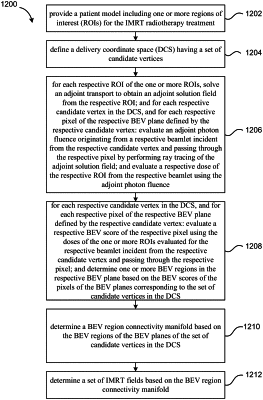| CPC A61N 5/1031 (2013.01) [A61N 5/103 (2013.01); A61N 5/1037 (2013.01); A61N 5/1039 (2013.01); A61N 5/1045 (2013.01); A61N 5/1081 (2013.01); G06T 7/0012 (2013.01); A61N 2005/1034 (2013.01); G06T 2207/20072 (2013.01); G06T 2207/30004 (2013.01); G06T 2207/30241 (2013.01)] | 9 Claims |

|
1. A method of beam angle optimization for an IMRT radiotherapy treatment, the method comprising:
providing a patient model including one or more regions of interest (ROls) for the IMRT radiotherapy treatment;
defining a delivery coordinate space (DCS) having a set of candidate vertices, each respective candidate vertex defining a respective beam's eye view (BEV) plane;
for each respective ROI of the one or more ROls:
solving an adjoint transport to obtain an adjoint solution field from the respective ROI; and
for each respective candidate vertex in the DCS:
for each respective pixel of the respective BEV plane defined by the respective candidate vertex:
evaluating an adjoint photon fluence originating from a respective beamlet incident from the respective candidate vertex and passing through the respective pixel by performing ray tracing of the adjoint solution field; and
evaluating a respective dose of the respective ROI from the respective beamlet using the adjoint photon fluence;
for each respective candidate vertex in the DCS:
for each respective pixel of the respective BEV plane defined by the respective candidate vertex:
evaluating a respective BEV score of the respective pixel using the doses of the one or more ROls evaluated for the respective beamlet incident from the respective candidate vertex and passing through the respective pixel; and
determining one or more BEV regions in the respective BEV plane based on the BEV scores of the pixels of the BEV planes corresponding to the set of candidate vertices in the DCS;
determining a BEV region connectivity manifold based on the BEV regions of the BEV planes of the set of candidate vertices in the DCS, the BEV region connectivity manifold representing connections between contiguous BEV regions between adjacent vertices; and
determining a set of IMRT fields based on the BEV region connectivity manifold, each respective IMRT field of the set of IMRT fields defining a beam angle corresponding to a respective vertex in the DCS,
wherein the IMRT fields are represented as a set of nodes, and the beam angle optimization includes finding the set of nodes that have optimal max-distance,
wherein the method further comprises selecting order of beam delivery in the set of IMRT fields, the selecting including determining a total time the beam is off during transitioning from one IMRT field in the set to another IMRT field in the set, and determining the order in which the beam is delivered based on minimum total beam-off time,
wherein the total beam-off time includes a time for acquiring one or more images for guidance of treatment between beam delivery, and
wherein the method further comprises limiting beam delivery in the set of IMRT fields to beams that can be delivered in a time-efficient order.
|